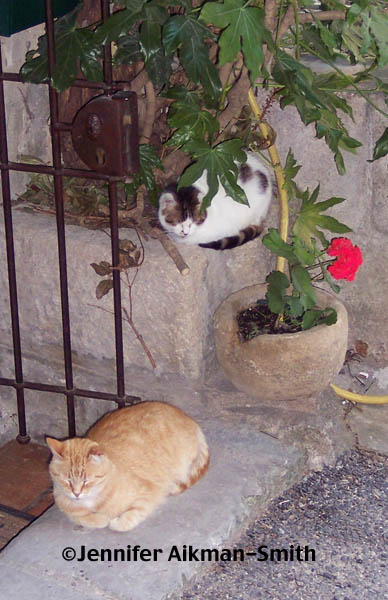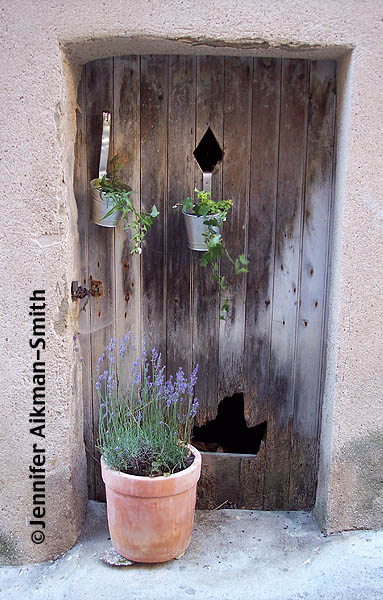
Provence Life Lesson Number Two:
Age Should Be Appreciated
North Americans fear aging. Countless ads offer products or procedures that will help us turn back the clock to keep us looking and feeling younger. Most people trade in cars or switch houses as soon as things begin to get worn out or cause trouble. Some even do the same with partners... trading in the older model for a younger one. Is it any wonder that our society feels a little bit worried about growing older?
I can already feel it in my bones some mornings, especially my hands. They are stiffer and creakier than they have ever been in my life. The artist worries what would happen if I couldn’t hold a brush or pencil or needle comfortably to create images any more.
My house is the same way. Nick and I have lived here for 17 years, but it was built 21 years ago. The stairs have recently begun to squeak more as we climb them, perhaps done in by the exuberance of my girls as they barrel up and down them with abandon, despite constant reminders from their parents not to “stomp up and down like a herd of elephants”! All the doors but one have been replaced as well as the roof and some of the window seals are starting to go. With a house, there is always something that will need your attention or your money, but there is also the sense of creating a home. Nick and I have lived longer in this house than either of us did anywhere while growing up. It is a place we have built together.
By Provence standards, our house is brand-spanking new! Wandering around villages where some of the buildings could trace a history of a thousand years, it was easy to see why one person I met called us a “cowboy culture”. He meant that North Americans were set in a more frontier mentality because we still had so much wide open space and our buildings were all so very young. We think of something over 100 years old as being “historic”. I saw one farmhouse being refurbished that had been built in the 1400s and was considered a “newer house to remodel compared to some!”

Every hill in Provence seems to have a village perched on it. Far rarer are the villages like Coustellet that are built on the flat plains. These are newer ones, planned out with care like many of our towns in comparison to the cluttered wonder on the hills. Given the history of the Luberon valley area, where huge battles fought during the Crusades caused the fields to “run red with blood”, it makes sense to built up on a hill where you can see an enemy coming.

Safety is provided by building on top of and in many cases almost INTO the hill on which the town or village is built.

Invariably, a church is near the very top of the village, closer to God and worth the climb.

Its bell tower, wrought of iron, is unique in its design and so is the sound of its bell. People used to know which village bell was which by its tolls indicating a call for help, a celebration or a death.

The rest of the village, almost every one we visited, then clusters down and around the church. Buildings rise and tangle with each other, leaning on each other for support to share common walls instead of sitting on individual lots of fenced in land as they do here. There is more of a sense of community with the buildings so close because nothing escapes anyone’s notice. To celebrate a sense of individuality without a huge lawn to mow, each house owner seems to have their own way to decorate the ancient stone with coloured blooms,

create shade for their cats to rest in

or grow potted herbs to add to meals along staircases, in window boxes or on doorsteps.

Any hole in the wall can hold a potted plant to become a thing of beauty.
We watched a grey cat streak in through the hole in this door.

I could only marvel at some of the cracks and spaces I could see in the buildings, imagining all to well how snow and cold would seep into such a space in Moncton.
Instead of a quest to make something look new and “perfect”, Provence seemed to celebrate making things that were old or worn still beautiful and worth appreciating.

This respect for age carried over into the food as well.
We drank a young wine created by a son taking over the winemaking business from his father and resurrecting an older almost extinct grape to make an amazing homage to his father called “À Mon Père” that is the best red wine Nick and I have ever had in our lives. It lived up to all of the memories we had from our last visit. The two bottles that we brought home with us are already gone, used for very special meals with friends, but the taste still lingers on the edges of my tongue.
As I mentioned before, cheese is an entire course in France and you can find everything from young, nippy one to cheese that has surely been aged inside a sweaty sock and buried deep within some well for hundreds of years before being served in tiny chunks to unsuspecting cheese lovers. One such pungent morsel left a smell that seeped under our fingernails and remained there despite much scrubbing with soap. My sister in law was horrified that she might carry that lingering smell on her business trip the next day and have people wonder why her handshake stank!
As an artist, I was also fascinated by the faces of the elders in each village, the ones who had earned their spot on the wall around the town’s fountain or courtyard, who sat in the sunshine waiting for a turn to play pétanque (a form of boules or lawn bowling played throughout Provence), who perched on chairs knitting and discussing those who walked by or sat under the awnings of the cafés sipping on something in the heat. Many of the faces, wrinkled and tanned by the strong sun, reminded me of the apple dolls I always tried to make. The sun and wind had weathered them as they lived their whole lives in this area, watching things change as tourists moved in, discovered the area, bought houses to transform and then left when each summer was over. People in Provence, and all over France for that matter, dressed with more care than most of us here in North America (no sweatpants or sloppy looks), but without trying to look younger. Perhaps it it simply that money is to be spent on other things that creams and potions. Many villagers in the area live on less than $25,000 a year quite well. It is a simpler life and there is less need to fill a house with the latest, fastest, newest things. Tables and other furniture get handed down over generations and they are built to last. A bit worn and loved, smoothed from years and many hands, but sturdier than almost everything in my house!

I came back from Provence with a determination to appreciate age and to embrace its steady march more easily. With a birthday looming just around the corner, I will remind myself every time I look at my girls, who have that boundless energy that takes my breath away, that my years have shaped and sculpted who I have become. By Provence standards, I am still a baby and my house is brand new!

